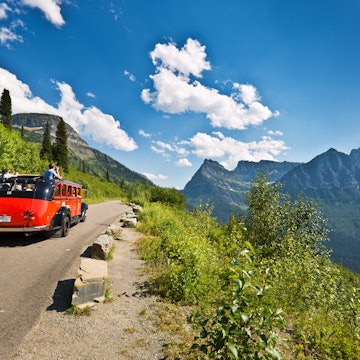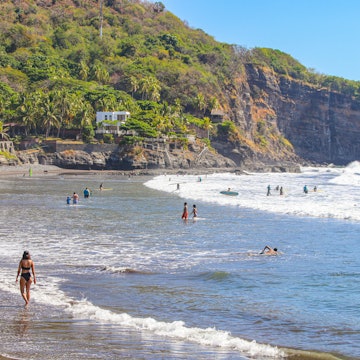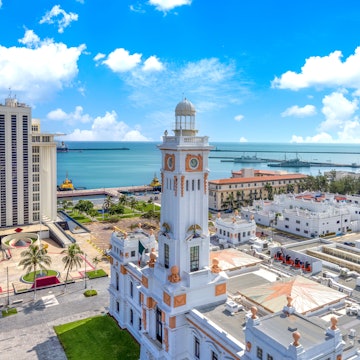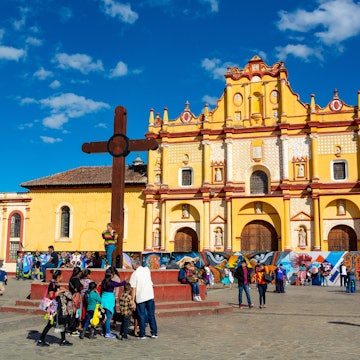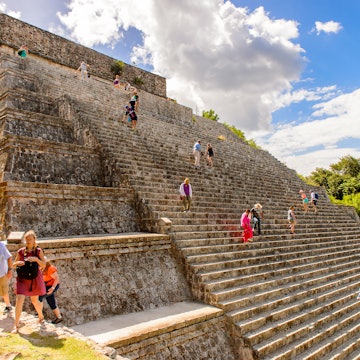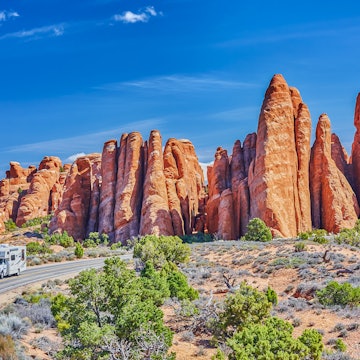

Performers in Los Lunes del Cerro, part of the celebration of Guelaguetza in Oaxaca City. Wirestock Creators/Shutterstock
With astonishingly biodiverse coastal, valley and mountain regions and a culture that pulsates with artistic creativity and deep-rooted Indigenous heritage, the state of Oaxaca epitomizes Mexico’s most special qualities.
Pre-Hispanic traditions and absorbing modern art thrive in and around culturally rich Oaxaca City, as do age-old practices in nearby mezcal country. Divine beaches and wetlands epitomize Oaxaca’s southern coast, while the misty mountains of the Sierra Norte provide enthralling wilderness escapes.
Here are the top experiences to enjoy all over the culturally rich, naturally blessed state of Oaxaca.

1. Set out on a mountain hike from Santiago Apoala
Apoala’s original Mixtec name, Yutatnoho, means “river where the lords come from” – and the scenery is indeed divine in this remote mountain village. Nestled in a valley 1970m above sea level and flanked by dramatic Yosemite-like rock formations, Santiago Apoala is a farming community of stunning natural beauty. Particularly impressive are a pair of mighty waterfalls that gush into pools with exceptional force, especially during the rainy season.
Three designated rutas (routes) lead visitors through all the natural beauty. Ruta 1 is a 4.2km out-and-back trail along the Río Apoala to Cola de Serpiente (Serpent’s Tail) and Cola de Caballo (Horse’s Tail), beautiful waterfalls over 30m tall. Further down, several swimming holes, including the turquoise Laguna Azul (Blue Lagoon), are perfect for cooling off. On the 1.8km out-and-back Ruta 2, guides point out hidden caves and ancient rock paintings on the way to Peñas Gemelas, towering twin peaks overlooking a narrow gorge. The hike squeezes between 150m-high canyon walls and passes small farms and fields of wildflowers. For the most adventurous, the 8km round-trip Ruta 3 includes Cueva del Diablo (Devil’s Cave), a twisting, turning cave leading to an underground lagoon. Admire ancient rock carvings near the cave’s entrance before continuing up to El Mirador, a lookout with sweeping views of the verdant countryside.
Local tip: After your adventures, fuel up with Oaxacan fare at Comedor Badu, a simple open-air spot on Apoala’s western end.

2. Join the festival throngs in Oaxaca City
Oaxaca City looms large in history and culture thanks to its folk art, vibrant Indigenous traditions and an innovative culinary scene that draws on age-old recipes. The vibe here peaks during two major festivals, celebrated by just about everyone in town.
Every October, Oaxacans turn their thoughts to their departed loved ones for Día de Muertos (Day of the Dead), a time-honored celebration created from a syncretism of pre-Hispanic traditions and Catholic days of observance for All Souls’ Day and All Saints Day. Though officially celebrated on November 1 and 2, by mid- to late October ofrendas (elaborate altars in honor of the dead) are set up in homes and businesses, and comparsas (Mardi Gras–like processions with soulful brass bands, traditional folk dancers and locals wearing festively macabre costumes) parade through Oaxaca City’s streets. The smell of copal incense envelopes the city, and fireworks explode everywhere.
Wander through Mercado Benito Juárez, where vendors sell everything from papel picado (vibrant paper garlands) and pan de muerto (a seasonal bread) to cempasúchil (bright-orange marigolds used to decorate altars). Meanwhile, a slew of restaurants prepare pozole (hominy stew) and elaborate mole dishes, both traditional Día de Muertos meals.
On the evenings of November 1 and 2, head to the Panteón General, the city’s main cemetery, which is decked out in flowers and candles, music filling the air. You’ll see families gather around their loved ones’ graves, eating, drinking and telling stories late into the night. Approach with the utmost respect – this is a celebration of remembrance, after all.
Every July, Guelaguetza (“gheh-lah-GHET-sah”), a cultural extravaganza and one of the year’s most animated fiestas, showcases folkloric dance, music and food hailing from Oaxaca’s eight regions. “Guelaguetza” is a Zapotec term that loosely translates as “reciprocal offering,” and though the current format dates to 1932, the celebration goes back to the pre-Hispanic era, when Indigenous communities would come together annually to pay their respects to Centéotl, the Mexica deity of corn.
The celebration centers around Los Lunes del Cerro (the Mondays on the Hill), a brilliant showcase of traditional dance performances in the open-air Auditorio Guelaguetza, an 11,000-seat hillside venue with sweeping views of the city. Shows are on the last two Mondays of July, typically two a day.
Planning tips: Día de Muertos is the busiest time of year in Oaxaca City, so book your hotel and airfare well in advance and expect peak-season rates. And Lunes del Cerro tickets during Guelaguetza always sell out – be sure to purchase those early.
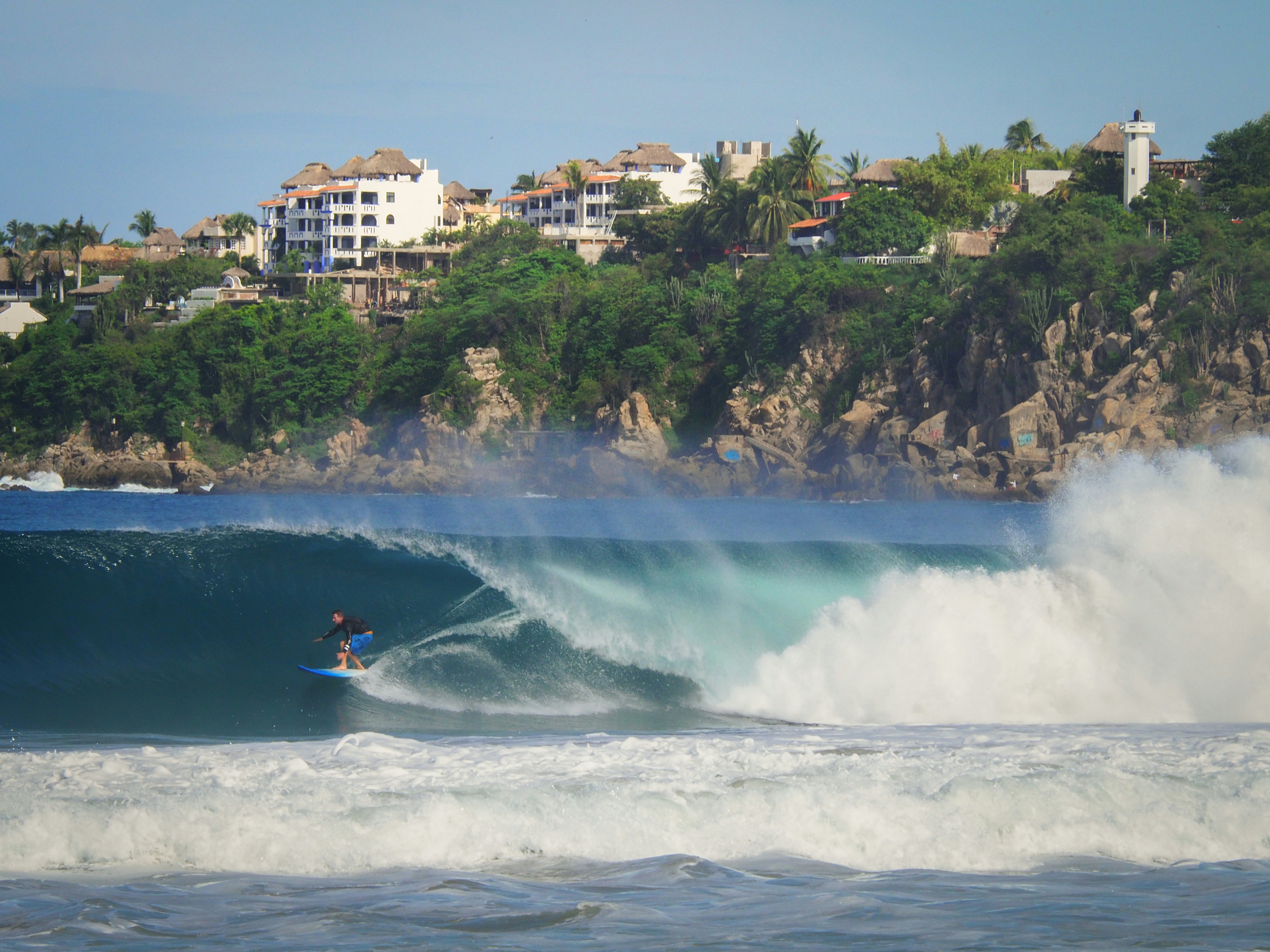
3. Take to the waves in Puerto Escondido
Once upon a time, long before paved roads reached this part of Oaxaca, Puerto Escondido was just a small fishing village living up to its name, “Hidden Port.” Nearly a half-century later, it has transformed itself into a legendary surf destination and one of Oaxaca’s fastest-growing beach resort towns.
At the center of it all is the 3km-long Playa Zicatela. Home to the pounding 6m-high waves of the Mexican Pipeline, the beach draws expert surfers and curious onlookers from across the world, especially in November, when several international surfing championships come to town. The rest of the year, early mornings are the best time to take in the waves, from either on the water or at a beachfront cafe.
But you don’t need to be a pro surfer to enjoy the water in Puerto Escondido. In the stylish Punta Zicatela neighborhood, Puerto Surf offers one-on-one and group classes; for multiday courses, you can shack up in its seven-room guesthouse. You’ll also find board rentals and surf classes on the lovely, horseshoe-shaped Playa Carrizalillo, where the beginner-friendly breaks make it very swimmable, too.
Detour: If you’re more interested in getting under the water than on it, Big Wave Diving offers diving and snorkeling outings to nearby sites. Puerto Escondido’s sole PADI dive center is only open from November through May, when water conditions and visibility are optimal. Amid reefs and volcanic rock, you can expect to glimpse spotted eagle rays, turtles and large schools of fish.

4. Get close to Zapotec culture in the Pueblos Mancomunados
High in the Sierra Norte mountains sit the Pueblos Mancomunados (United Villages), a commonwealth of eight Zapotec villages devoted to sustainable tourism and subsistence farming. For 400 years, these remote villages (Amatlán, Benito Juárez, Cuajimoloyas, Lachatao, La Nevería, Latuvi, Llano Grande and Yavesía) have pooled the natural resources of their 290-sq-km territory, sharing profits from forestry and other enterprises that worked the land. Since 1998, they have collectively turned to ecotourism as a way to protect their natural resources while also earning a living.
Visiting the different Zapotec villages, staying overnight and eating in comedores (basic restaurants) provide windows into the local culture. If you’re interested in a deeper dive, each community also offers talleres (workshops) designed to share Zapotec ways. Held in people’s homes and farms, these sessions allow you to learn from locals directly, in their spaces and in their style – ultimately providing a meaningful way to connect with community members.
Talleres include weaving workshops, where you’ll work with traditional looms and natural dyes, creating textiles from materials such as plants and cochineal insects. Medicinal-plant talleres involve collecting plants in the forest, learning about their healing properties then prepping them for use. Some workshops focus on sustainable practices, such as organic farming and beekeeping. Then there are cultural experiences such as participating in a temascal, a traditional sweat bath used since ancient times for spiritual healing, purification and treating physical ailments.
Planning tip: Contact Expediciones Sierra Norte to join a taller; access must be arranged in advance. Participation starts at M$150.

5. Tap into Zipolite’s alternative lifestyle
A bastion of counterculture expression since the 1970s, Zipolite attracts independent-minded travelers who come for its clothing-optional beach (the only legal one in Mexico), chilled-out party scene, superb palapa (thatched-roof) seafood restaurants and and generally unabashed do-nothing vibe.
Most of the action unfolds along the 1.5km-long town beach and El Adoquín (aka Av Roca Blanca), a strip of oceanfront restaurants, intentionally rustic hotels and palapa bars. On Playa Zipolite, you’ll see people swimming, sunbathing or happily walking across the sand sans clothes at any time of day. Nudity is more common on the beach’s bookends, including the small Playa del Amor bay at the east end, which is a favorite spot for gay men.
Planning tip: If you want to max out on Zipolite’s countercultural vibe, plan your visit for late January and early February, when the annual Festival Nudista takes place. This celebration of nakedness and body positivity features beach yoga sessions, body-painting workshops, volleyball and soccer tournaments, live-music performances, communal dinners and parties – all clothes-free, and mostly cost-free too.

6. Explore the protected coastal landscapes of Bahías de Huatulco
Bahías de Huatulco (or simply Huatulco) was once merely a smattering of small fishing villages, but has morphed into one of the largest tourist centers on the Oaxaca coast. Developed with an ecological focus, a large area of Huatulco’s lowland jungle and marine habitat is protected as a national park, making some of its quieter coves a joy to experience through hiking, snorkeling and swimming.
Parque Nacional Huatulco comprises a vast area of wildlife-rich jungles, wetlands and sublime beaches hugging a stretch of virtually untouched coastline. It’s home to dolphins, sea turtles, more than 300 types of birds, 9000 plant species and about 110 acres of coral reefs. Along several trails that cut through the dense jungle, you can reach some of the most remote bays on foot. There’s no development, no one selling shiny jewelry, no tourists getting braids: it’s just you and a wild beach. Wear decent walking shoes, and bring provisions and snorkel gear.
Among the easiest bays to reach, Playa Cacaluta is a seldom-visited slice of paradise with tranquil waters accented by a verdant island, the rocky shores of which make for good snorkeling. It’s at the end of the well-maintained 2.5km Sanate trail, just west of the turnoff to Bahía Maguey. For a shorter, easier hike, head 1.3km east to Bahía El Órgano, where a flat 1km trail through the forest leads to a wondrous crowd-free cove. If possible, bring a beach umbrella – there’s very little shade.
If you’re looking to break a sweat, tackle the rocky, moderately steep trail to Playa El Violín. The 1.6km out-and-back trail ends at the tawny beach, its tranquil waters dotted with dramatic rock formations that are home to school upon school of fish.
Planning tip: After a full day in nature, charming La Crucecita, the region’s sole city, provides plenty of local flavor in the form of weaving workshops, a busy food market and sidewalk restaurants that overlook the sun-soaked main square and colonial-style church.

7. Consider a psychedelic experience in San José del Pacífico
Some 2500m above sea level in the Sierra Madre mountains, San José del Pacífico (sometimes called just Sanjo) is a serene village that offers a cool, tranquil escape amid a peaceful, cloud-shrouded forest. A place where the connection to nature and spirituality is paramount, San José is renowned for the prevalence of the hallucinogenic mushroom Psilocybe mexicana, which grows in the surrounding pine forest and is openly sold in village shops.
Though their consumption is officially illegal, hongos mágicos (magic mushrooms) have long been consumed by locals for ceremonial purposes; Indigenous traditions hold that their use facilitates communication with deities and ancestors. Today, the native mushrooms have drawn a community of alternative-lifestyle types to the village.
San José also is known for the temascal, an age-old ritual symbolizing purification, healing and renewal. You’ll see signs for these steam baths around town, often directing you to secluded forest retreats, where the natural surroundings are said to amplify the effect. The mushroom-themed Teteo Innan Alma, at the town’s south end, is a recommended temascal, with the owner, Goyo, leading the four-stage mediation. The on-site restaurant also hosts a small but worthwhile wild mushroom festival every year in July or August.
Planning tip: Bring cash with you. In this remote village, few places accept credit cards and there’s no ATM.

8. Find empty beaches in the Istmo de Tehuantepec
The sultry Istmo de Tehuantepec (known as the Istmo) sees far fewer visitors than its coastal counterparts to the west and is undoubtedly one of Oaxaca’s most under-the-radar destinations. Travelers visit for a taste of the region’s uniquely savory cuisine, Zapotec culture and wild, dune-backed beaches.
Stretching about 200km from the shores of Veracruz to the Gulf of Tehuantepec, the Istmo forms Mexico’s narrowest corridor between the Atlantic and Pacific, which means it’s been a key transport route since colonial times. When the inland cities start to feel unbearably hot, head for the Istmos’ wild coastal region to cool off on crowd-free white sands. Granted, this mostly undeveloped stretch of coast has little in the way of tourism infrastructure, but makes up for it with its stunning dune-backed beaches and sweet surf spots.
La Bamba (aka Concepción Bamba) and nearby Chipehua are known for their sweeping sandy beaches, big swells and colossal sand dunes. La Bamba is a gorgeous, undeveloped beach with two point breaks in the middle; peak surfing season is from March to October, but swells don’t come every day, so check forecasts. The beach also is a sea-turtle nesting zone: from October to March, you’ll often see olive ridley and green sea hatchlings scurrying to the sea in the evenings.
In Chipehua, the monster sand formations on the beach’s south end are a sight to behold, especially during the rainy season (May to October), when natural freshwater pools form, dotting the sandy landscape with sparkling swimming holes. Sandboarding also is possible here (BYO equipment). On weekends, join local families on the beach when the palapa huts do brisk business in grilled fish and cold beer.
Planning tip: Outside of the Istmo’s cities, gas stations are few and far between. If you’re driving, be sure to fill up before you hit the road, or whenever you pass a station.
This article was adapted from Lonely Planet’s Mexico guidebook, published in October 2025.








